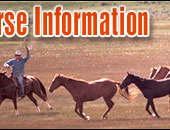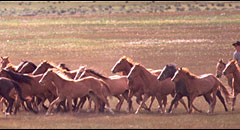 |
   |
|
|
|
You are here: > Horses > Horse care > Horse Dehydration |
Prevent Dehydration and Horse Colic By Heating Drinking Water in Winter
While most horse owners naturally monitor their horseís
water intake during the hot summer months, many relax that
vigilance during the winter. However, getting enough water
during cold weather is just as important as it is during hot
weather. |
|
|
Horses need less water during the winter, and therefore,
naturally drink less. However, often they drink too little.
Researchers have discovered that this tendency to drink too
little water can be countered by simply offering your horses
warm water during the winter. But does it really make that much difference how much water
your horse drinks? |
Absolutely. According to research done at the University of
Pennsylvania, there are anecdotal correlations between
decreased water and fecal impaction colic. Increasing the
amount of water a horse drinks is an easy and inexpensive
way to keep your horse at the peak of health during the
winter.
A research project completed at the universityís New Bolton
Center proved that ponies, when offered warm water or
near-freezing water, drank a whopping forty percent more
warm water. This statistic remained constant whether the
ponies were offered water that was kept warm constantly, or
if their drinking buckets were simply filled with warm water
twice daily. The ponies drank the most within three hours
after feeding, or after the water containers were refilled.
This study also showed that the ponies actually drank more
water than indicated in previously published maintenance
requirements when they were offered warm water. The ponies
in the study group drank an average of 9.9 liters daily, or
about two and a half gallons. This is sixty-two percent more
than the maintenance guideline of only 6.1 liters per day.
Providing warm water is relatively easy for horses that
winter indoors, but turn-outs provide a bit more of a
challenge.
Automatic waterers are a good solution for outdoor wintering
horses. There are many different models available, including
some constructed of rust-proof polyethylene plastic. Making
sure that the waterer is correctly installed is the most
important key in preventing problems later on.
When installing the automatic waterer, make sure that the
water pipes to the unit are below the frost line. Also,
check the watererís reputation for reliability of the
heating unit before purchase.
However, donít rely entirely on your automatic waterer.
Problems and malfunctions happen, even in the most expensive
or reliable models. The waterer should be checked, and the
water pan cleaned, daily.
If an automatic waterer is not an option, consider carrying
buckets of hot water out twice daily to the horses. Mix a
little cold water from the barn tap before offering it to
the horses, creating a nicely warm drink. If you are
wondering how warm or cool to make it, remember, if you
would not drink the water, donít ask your horse to drink it.
There are other ways to heat water for your horses. One
water heater model is created to float in a stock tank.
Completely enclosed in Styrofoam and plastic, the heater is
controlled by a thermostat and has an automatic shut off.
This is a popular option for cattle, but given horsesí
tendency to play with objects, it may not be practical for
horses.
Other types of heaters and de-icers donít float. Some,
equipped with automatic shut-off and thermostat control, are
designed to sit on the bottom of the tan to prevent the
livestock from disturbing them. Others attach to the side of
stock tanks, clamping securely on to prevent playful horses
from removing them from the water. The heating elements run
along the bottom of the tank, to prevent accidental burns.
Thermostats are adjustable and replaceable in case of
malfunction.
Other heaters are not able to be immersed, and can be more
affordable. These are for use under metal buckets, waterers,
fountains, or other water holders. There are also de-icers
designed for use in buckets, but since they can heat the
water all the way to boiling, they cannot be left in place
or unattended.
One of the newest heaters available is a drain plug de-icer
made to be used with the popular Rubbermaid stock tanks.
This unit installs, as the name suggests, through the drain
plug opening. This keeps the electrical cord out of the way.
The unit is also controlled by a thermostat.
Other watering devices require no electricity. These can
still prevent water from freezing by limiting its exposure
to the air, or by using the heat from the ground. These do
not tend to keep the water as warm as electric heaters,
however.

|
Read the next horse care article on Winter Horse Care and Blankets. |
|
|
|
|
 |
|
|
|
|
|
Horse Education
|
|
|
|
|
Horse Information Topics
|
|
|
|
|
|
|
|
Horse Business Owners
|
| |
Advertise with Us
Have your horse products or services exposed to over 27,000 of our monthly visitors.
|
|
|
|
|
|